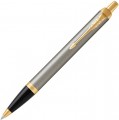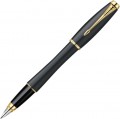—
Ballpoint. The most popular type of pens nowadays. The name is due to the fact that the basis of the writing mechanism in such pens is a special ball the size of a fraction of a millimetre: it is wetted with pasty ink and, rolling along the paper, leaves a trace. Ballpoint pens are simple, reliable and at the same time inexpensive, have a fairly long service life, and their ink does not smudge even on “loose” paper. On the other hand, writing such a pen requires more effort than a fountain or gel pen; this may degrade the quality of the handwriting. In addition, the ball mechanism does not work on almost any surface other than paper, and such a pen quickly stops writing on a horizontal surface (however, the exception to both cases are “space” models, see “Features”).
—
Gel. A variation of the ballpoint pens described above that uses gel-like ink. Also, such models differ somewhat in the design of the writing unit, due to which they require less effort for writing. This provides additional convenience and can even improve the quality of handwriting (sometimes poor handwriting is associated precisely with the less convenient ballpoint pens). In addition, gel ink is suitable not only for paper, but also for many other types of surface. Among the cons of this option, there are a slightly longer ink drying time than for ballpoint pens, a rather high rate of their consumption, as well as a tendency to “
...spread” on loose paper.
Also note that the gel in our catalog also includes the so-called rollerball pens: they use an improved writing mechanism, water-based ink (as in fountain pens), somewhat more convenient than classic gel pens, but otherwise completely similar.
— Fountain. The oldest type of pen produced today. They have a writing part in the form of a metal "feather" with a narrow channel in the middle; through this channel, the ink comes from the reservoir built into the pen to the tip of the pen. For refueling, both special pumps (in more expensive models) and replaceable capsules (in entry-level models) can be used. Anyway, one of the practical advantages of this design is the minimal resistance when moving across the paper (this makes fountain pens, in particular, perfect for initial write learning). On the other hand, even the simplest of these devices are much more expensive than ball and gel models. Therefore, nowadays, most fountain pens are fashion accessories, designed not so much for everyday use, but to emphasize the status of the owner. The pen in such models can be made of expensive metals, such as gold or platinum. However, there are also the contrary models — relatively simple and inexpensive fountain pens for everyday use.
— Multifunction. Models that have one or another additional “writing” function, in addition to the pen itself. Most multifunctional models combine a pen and pencil (see "Features"), but there are other options — for example, a pen with a marker on the opposite side from the writing nib.
— Technical pen. A special kind of pen that works on the capillary principle: ink is supplied from a container through a rod with many microscopic channels. Felt-tip pens work on a similar principle; liners differ from them in a relatively small line thickness. However, this thickness can be different; and in some models, the nib has a beveled shape (similar to some paint brushes), which allows it to be used for both thin and wide strokes. Anyway, the technical pens are intended more for drawing than for writing: they are convenient for sketching, drawing the outlines, etc. However, nothing prevents using such a device when writing, especially since the technical pens does not require much effort when moving on paper.—
Retractable. Retractable pens: before use, the tip of the refill with a writing element extends from the body, and when the pen is not needed, it hides back. The refill is controlled using a button on the top of the pen, by turning the upper or lower part of the body, by a lever on the body, etc. This function is similar to that of a protective cap: preventing the nib from drying out and protecting it from unwanted contact with surrounding objects (for example, in a bag). However, retractable pens are much more convenient than pens with caps due to the fact that there is no risk of losing the cap, etc. Among the disadvantages are the complicated design, which increases the cost and increases the risk of breakage, as well as the need to use specially designed refills.
—
Multicolor. Pens that have several refills of different colours at once — usually from 2 to 4. This allows you to write and draw in several colours, switching between them on the go and not letting go of the pen. Only retractable pens can be multicoloured (see above). At the same time, the four-colour models usually have blue, black, red and green refills as standard. And two-colour pens use one or another combination of these colours — usually one "main" (blue or black) and one "additional" (red or green). However, anyway, nothing prevents the installation of other refills, with "non-native" colours.
—
Space pen. Pens of increased reliability, based on writing instruments used in space flights. One of the features of such pens is that the ink inside is in a solid state and liquefies only immediately before being fed to the nib, and the supply itself occurs under a pressure of about 2 atmospheres. This allows such a pen to write in any position, including horizontal and inverted, as well as to function effectively in extreme conditions: in rarefied air at high altitudes (more than 3 km), in severe frost or heat, and even under water. However, the cost rate of "space" models is respectively high.
—
Pencil. Pens with mechanical pencil function. Note that the specific implementation of this function may be different. In most cases, we are talking about multifunctional devices (see "Pen type"), where switching from pen to pencil and back occurs due to the change of the working part. If the pen is not multifunctional, then a pencil means a completely separate mechanical pencil supplied in the kit.
—
Eraser. The presence of a built-in erase in the design of the pen. Its main purpose is to erase pencil lines, although there are also erasers that can work with ink. Anyway, if the pen has an eraser, you do not have to purchase it separately; and it’s quite difficult to lose such an eraser, except perhaps along with the entire pen. The eraser is usually installed in the upper part, at the very end, and is often covered with a protective cover.
—
Stylus. The ability of the pen to work as a stylus — a pen for a touch screen in a smartphone, tablet, etc. The role of the working part of the stylus is usually played by a special tip on the opposite side of the writing mechanism. Note that by default, modern touch screens are designed for finger control, but the stylus will be more convenient for tasks that require increased precision, such as drawing.
—
Clip. The item in the form of a clip, most often on the top or cap of the pen. The clip allows you to conveniently attach the product — for example, on the cover of a notebook or on the edge of a pocket. Thus, the pen will always be at hand, and you do not have to waste time searching it.
—
With a case. The presence of a case in the pen package. It protects both the pen itself and the objects surrounding it from damage and dirt, and also makes it easier to search among the abundance of things (for example, in a bag): the dimensions of the case, although compact, are significantly larger than those of the pen itself, and it is much more noticeable while searching it. In addition, in expensive fashion-class models, the case is also a stylish accessory, similar to the pen itself.

